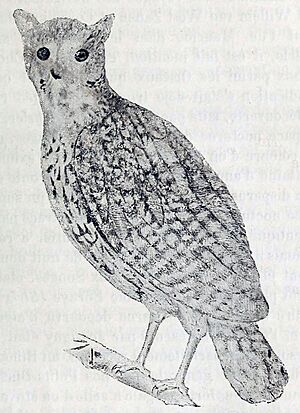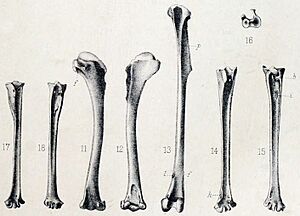Mauritius scops owl facts for kids
Quick facts for kids Mauritius scops owl |
|
|---|---|
 |
|
| Pencil drawing of a recently killed specimen by Paul Philippe Sanguin de Jossigny, from around 1770 | |
| Conservation status | |
| Scientific classification | |
| Genus: |
Otus
|
| Species: |
sauzieri
|
 |
|
| Location of Mauritius | |
| Synonyms | |
|
Strix sauzieri Newton & Gadow, 1893 |
|
The Mauritius scops owl (Otus sauzieri) was a type of owl that used to live only on the island of Mauritius. It is now extinct, meaning it no longer exists. People also called it the Mauritius owl, Mauritius lizard owl, Commerson's owl, Sauzier's owl, or Newton's owl.
We know about this owl from several things. These include old bones found in a swamp called Mare aux Songes. There is also a detailed drawing from 1770 by de Jossigny. Another important record is a description from 1836 by Desjardins of an owl that was shot. The first reports of owls on Mauritius came from sailors like Van Westzanen in 1602 and Matelief in 1606.
Contents
Understanding the Mauritius Scops Owl
For a long time, scientists were confused about the owls on Mauritius. This was because no one wrote about owls between the mid-1600s and the late 1700s. Also, the bones found seemed to be from owls without ear tufts, like Strix owls or barn owls. However, the old drawing and descriptions clearly showed owls with ear tufts.
Because of this, people thought there might have been two or even three different owl species on the island. For example, the supposed "barn owl" Tyto newtoni was described from leg bones. These bones likely belonged to a male Mauritius scops owl. The main bone used to identify the Mauritius owl seemed to be from a larger female bird.
What Kind of Owl Was It?
It turned out the Mauritius owl was not a Strix owl or a barn owl. Instead, it was part of a group called the Mascarene owls. These owls were most likely related to the scops owls. The Mauritius scops owl was the biggest of its kind, growing to about 60 cm (2 feet) long. Its scientific name, sauzieri, honors Théodore Sauzier. He was the person who first made the owl bones available for scientists to study.
Family Tree of the Scops Owls
In 2018, scientists did a DNA study on the Mascarene owls. They found that these owls, including the Mauritius scops owl, belong in the Otus genus, which is the group for scops owls. The chart below shows how the Mauritius scops owl is related to other scops owls:
|
||||||||||||||||||||||||||||||||||||||||||||||||||||
Why the Mauritius Scops Owl Disappeared
Before humans arrived, the Mauritius scops owl was the biggest hunter on the island. This meant that new animals like cats, rats, and crab-eating macaques, which humans brought, did not affect it much at first. Unlike other local birds, it was able to handle these new predators.
In the 1830s, people still saw the Mauritius scops owl quite often. It lived in the southeastern part of the island, between Souillac and the Montagnes Bambous. The last time anyone reported seeing these owls was in 1837.
However, as people started growing more sugarcane and tea, the owl's natural home, its habitat, began to shrink. People also hunted the owls without thinking. Because of these reasons, the Mauritius scops owl quickly disappeared. By 1859, a naturalist named Clark wrote that the bird was completely extinct.




